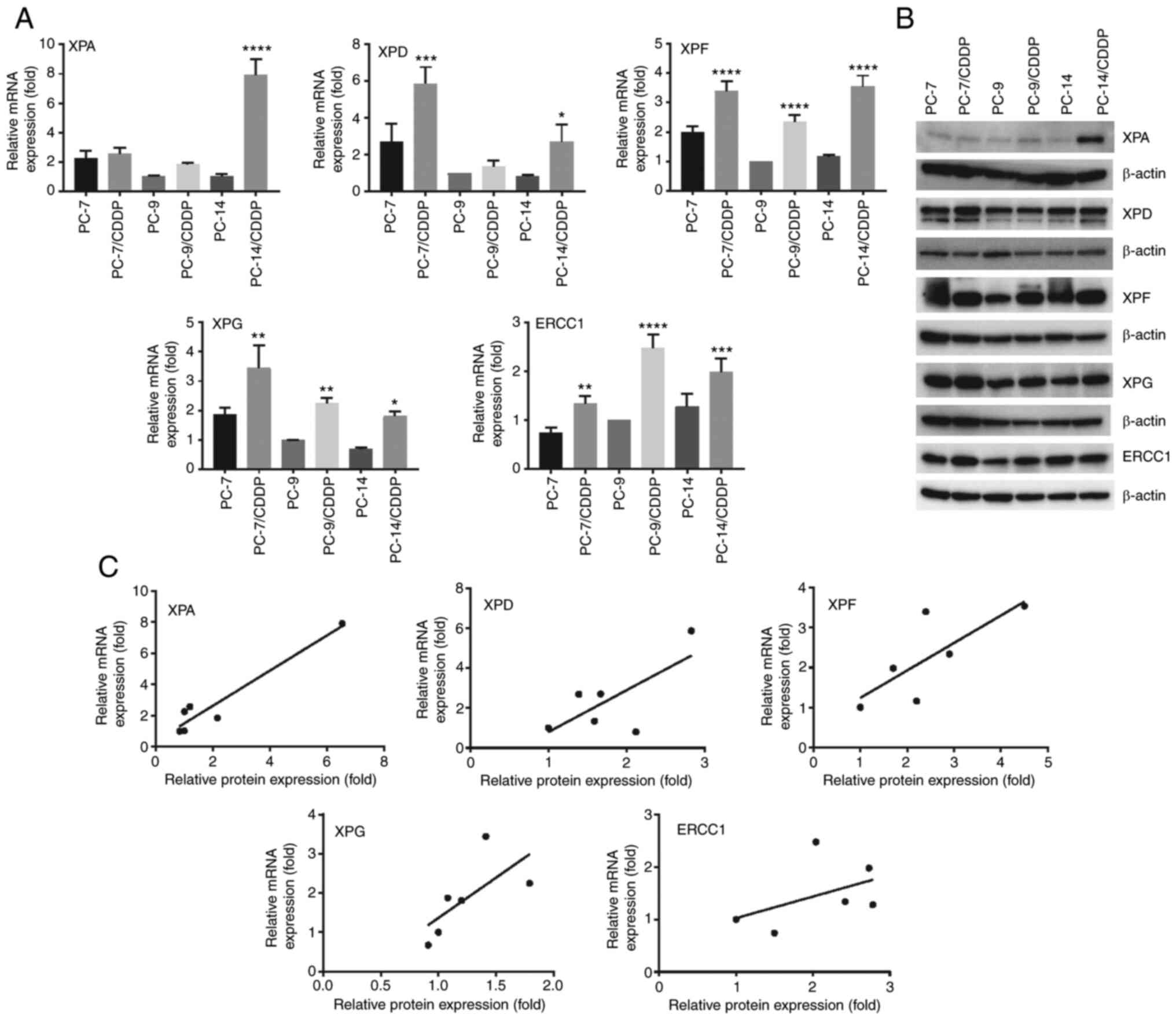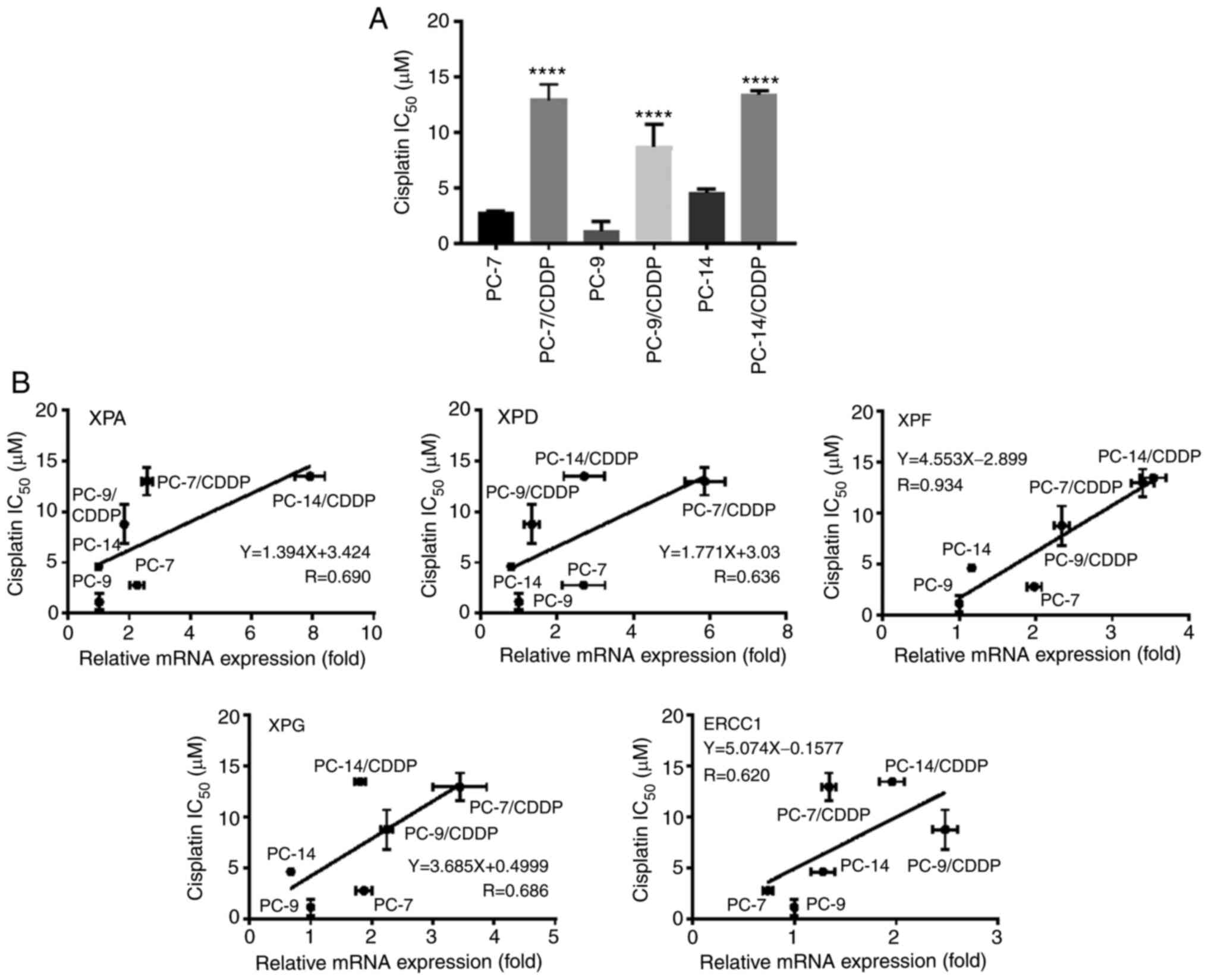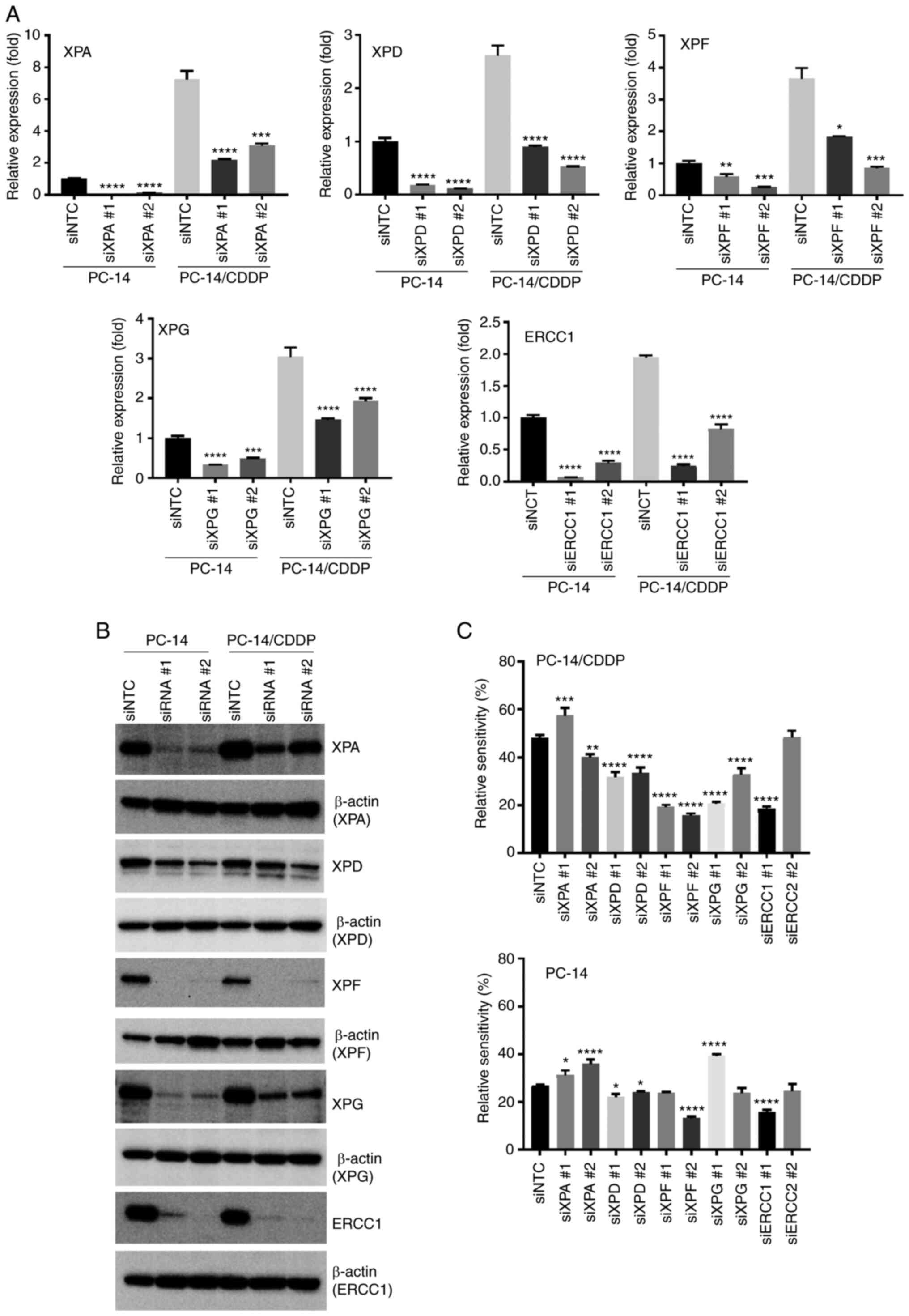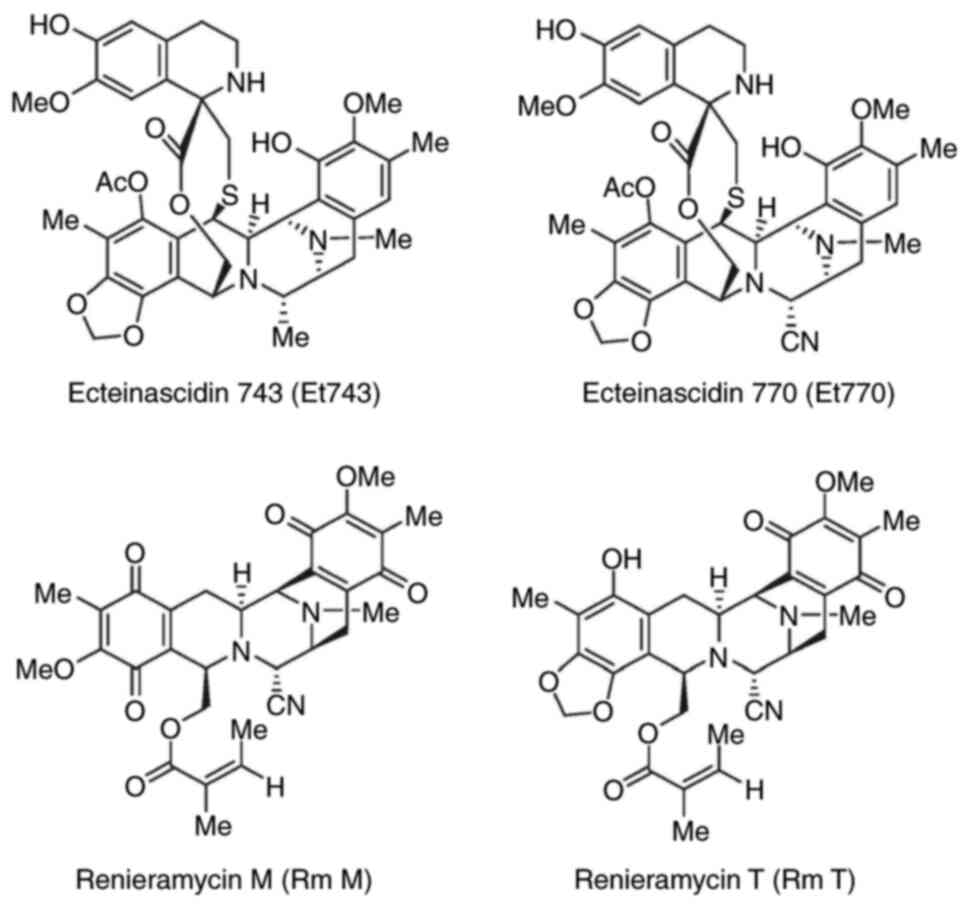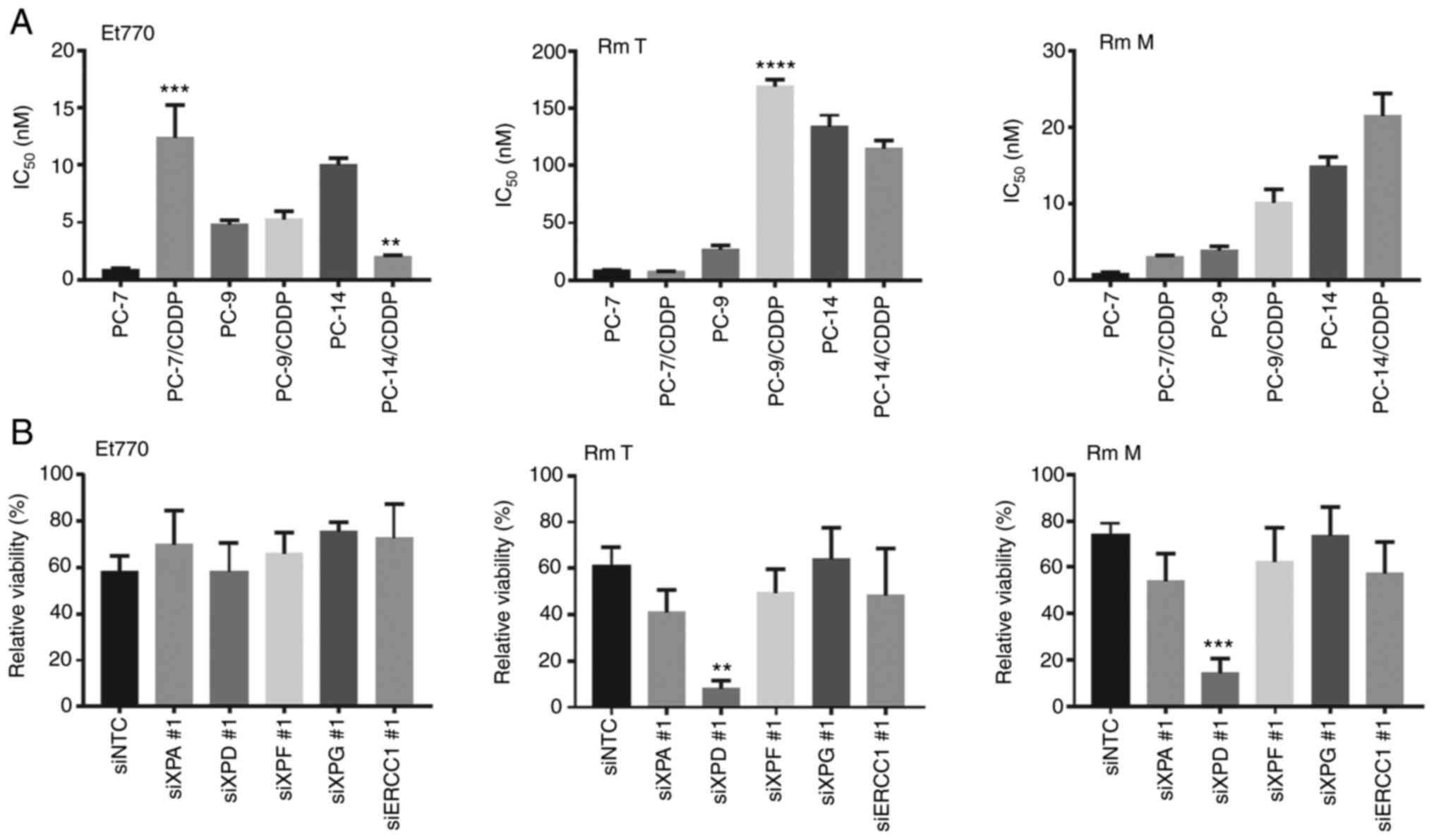Characterization of the nucleotide excision repair pathway and evaluation of compounds for overcoming the cisplatin resistance of non‑small cell lung cancer cell lines
- Authors:
- Published online on: February 10, 2022 https://doi.org/10.3892/or.2022.8281
- Article Number: 70
Abstract
Introduction
Lung cancer is the leading cause of cancer-related mortality worldwide. Non-small cell lung cancer (NSCLC) occurs in ~85% of patients with lung cancer (1). Recently, several driver gene aberrations, including epidermal growth factor receptor mutations and anaplastic lymphoma kinase gene rearrangements, have been reported to play a crucial role in the occurrence of NSCLC, against which corresponding targeted molecular therapeutics have been developed. Targeted therapies against NSCLC harboring such mutations have exhibited notable success (2); however, ~30% of patients with NSCLC in Japan lacking driver oncogene aberrations do not obtain optimal clinical benefits from these treatments (3). Platinum-based combination chemotherapy, including cisplatin and pemetrexed, is still being used as the standard therapy for patients with NSCLC lacking driver mutations. However, the development of cisplatin resistance is a major obstacle for cancer treatment. Accordingly, the development of novel therapeutic strategies for NSCLC is of utmost importance for overcoming cisplatin resistance.
Cisplatin resistance-related cellular mechanisms have been revealed to be multifunctional, including decreased cisplatin accumulation, increased intracellular detoxification, and increased DNA repair ability (4,5). Nucleotide excision repair (NER) is a principal and well-known repair system for chemotherapy-induced DNA damage (6). The xeroderma pigmentosum complementation group proteins (XPA, XPC, XPD, XPF, and XPG) are involved in the NER pathway, including in the damage recognition, unwinding, excision and refilling of DNA (7,8). Previously, it has been reported that XPC protein contributes to the sensitivity of colorectal cancer cells to cisplatin (9), and the overexpression of XPF and XPG mRNA has been associated with the sensitivity of ovarian and colon cancer cells to cisplatin (10). Moreover, XPA, XPC and XPD proteins modulate the sensitivity of gastric cancer cells to cisplatin (11). NER pathways that are involved in the response or resistance to cisplatin have been reported in a number of types of cancer, including testicular and ovarian cancer, and NSCLC (7). However, the role of DNA repair in cisplatin resistance is not yet fully understood in cisplatin-resistant NSCLC, including multiple mechanisms of cisplatin resistance.
Ecteinascidin (Et)743 (Trabectedin, Yondelis®) has been approved for use in soft tissue sarcoma and ovarian cancer. The unique mechanism of Et743 involves double-strand breaks induced by the NER pathway following covalent binding to the N2 of guanine located in the DNA minor groove (12–14).
In the present study, the expression levels of NER pathway-associated genes in cisplatin-resistant NSCLC cell lines were investigated and the effects of Et analogs on cisplatin-resistant NSCLC cell lines in which the NER pathway was altered were evaluated.
Materials and methods
Chemical and reagents
Et770 and Renieramycin M (RmM) were isolated by the authors from the Thai tunicate Ecteinascidia thurstoni (15) and the Thai blue marine sponge Xestospongia sp. (16), respectively. Renieramycin T (RmT) was synthesized using RmM in the Department of Pharmaceutical Chemistry, Meiji Pharmaceutical University (Tokyo, Japan). Their chemical structures were determined as previously described (17–19). For stock solutions, all chemicals were dissolved in dimethyl sulfoxide at a concentration of 10 mM and then further diluted to the working concentration prior to use.
Cell lines
Three NSCLC cell lines, PC-7, PC-9 and PC-14, and the cisplatin (CDDP)-resistant sublines (20), PC-7/CDDP, PC-9/CDDP, and PC-14/CDDP were kindly provided by Professor Kazuto Nishi (Kinki University School of Medicine, Osaka, Japan). The cells were maintained in RPMI-1640 (Wako Pure Chemical Industries, Ltd.) supplemented with 10% fetal bovine serum (FBS) (Nichirei Biosciences Inc.), 100 U/ml penicillin and 100 µg/ml streptomycin at 37°C with 5% CO2 in a humidified incubator. These cell lines were authenticated using STR DNA profiling analysis at the Japanese Collection of Research Bioresources Cell Bank.
Cell proliferation assays
In order to evaluate the growth inhibitory effects of Et770, RmT and RmM on cisplatin-resistant NSCLC cell lines, the cells were seeded in 96-well microplates at a density of 2,000-3,500 cells/well in RPMI-1640 supplemented with 10% FBS, 100 units/ml penicillin and 100 µg/ml streptomycin. The cells were then treated with various concentrations of the test samples for 96 h. Cell viability was evaluated using a Cell Counting Kit-8® (Dojindo Laboratories, Inc.) or ATPlite® 1 step reagents (PerkinElmer, Inc.) according to the manufacturer's instructions. The IC50 values were determined using GraphPad Prism 7.04 software (GraphPad Software, Inc.).
Reverse transcription-quantitative polymerase chain reaction (RT-qPCR)
Total RNA from the cultured cells and siRNA-transfected cells was isolated using the miRNeasy® Mini kit (Qiagen GmbH). The purity and concentration of the total RNA were assessed using a UV-visible spectrophotometer V730 (JASCO Corporation). cDNA was synthesized from 1 µg total RNA using ReverTra Ace® qPCR RT Master Mix (Toyobo Life Science) at 37°C for 15 min, then 50°C for 5 min, followed by 80°C for 10 min. PCR was performed using converted cDNA and the following reagents: TaqMan Gene Expression Assays® for human XPA (assay ID Hs00166045_m1), XPD [excision repair cross-complementation group (ERCC)2; assay ID Hs00361161_m1], XPF (ERCC4; assay ID Hs00193342_m1), XPG (ERCC5; assay ID Hs01557031_m1), excision repair cross-complementation group 1 (ERCC1; assay ID Hs01012156_m1), and GAPDH (assay ID Hs02758991_g1) genes (Thermo Fisher Scientific Inc.), and the Luna Universal Probe qPCR Master Mix (New England BioLabs, Inc.). XPA, XPD, XPF, XPG, and ERCC1 mRNA expression levels were assessed by using RT-qPCR with the Quant Studio® 5 Real-Time PCR System (Thermo Fisher Scientific Inc.). The thermocycling conditions were as follows: 95°C for 60 sec, followed by 40 cycles of 95°C for 15 sec and 60°C for 60 sec. Relative gene expression levels were determined using the comparative cycle threshold method (2−ΔΔCq), using GAPDH as the reference gene. ΔCq was calculated by subtracting the Cq of GAPDH from that the target gene Cq (21).
SDS-PAGE and western blot analysis
Soluble proteins were extracted from the PC-7, PC-9, PC-14, PC-7/CDDP, PC-9/CDDP and PC-14/CDDP cells using RIPA buffer (Nacalai Tesque Inc.), supplemented with a protease inhibitor cocktail and a phosphatase inhibitor cocktail (Nacalai Tesque Inc.). Sample protein concentration was determined using a BCA protein assay kit (Thermo Fisher Scientific Inc.) with bovine serum albumin as the standard. Briefly, 20 µg proteins/well were separated using 5–20% SDS-polyacrylamide gels (ATTO Corporation) and transferred to a nitrocellulose membrane (Wako Pure Chemical Industries, Ltd.). After blocking with BlockAce (KAC Inc.) at room temperature for 1 h, the membranes were incubated with the following primary antibodies overnight at 4°C: XPA (dilution, 1:5,000; cat. no. sc-56813; Santa Cruz Biotechnology, Inc., XPD (dilution, 1:3,000; cat. no. GTX108948) and XPF (dilution, 1:5,000; cat. no. GTX129285) (both from GeneTex, Inc.), XPG (dilution, 1:1,000; cat. no. 11331-1-AP; Proteintech Group, Inc.), ERCC1 (dilution, 1:300; cat. no. A5291; ABclonal, Biotech Co., Ltd.) and β-actin (clone C4; dilution, 1:5,000; cat. no. MAB1501; Merck KGaA). All membranes were then incubated with HRP-labeled secondary antibodies (dilution 1:10,000; anti-rabbit, cat no. PI-1000; anti-mouse, PI-2000; Vector Laboratories, Inc.) at room temperature for 1 h. After washing with 0.1% Tweew20 containing PBS, specific signals were detected using an Immobilon Western Chemiluminescent HRP substrate (Millipore Sigma). Each band intensity was calculated using Image Lab. 5.2 software (Bio Rad Laboratories, Inc.).
siRNA transfection
RNAi knockdown was performed on the PC-14 and PC-14/CDDP cellsy using Lipofectamine RNAiMAX (Thermo Fisher Scientific Inc.) according to the manufacturer's instructions. siRNAs against XPA (siRNA ID s532043 forward, GGGAGACGAUUGUUCAUCATT and reverse, UGAUGAACAAUCGUCUCCCTT; s14926 forward, GAAUUGCGGCGAGCAGUAATT and reverse, UUACUGCUCGCCGCAAUUCTT), XPD (ERCC2; siRNA ID s4787 forward, GAUUCGUGAGAAUGACUUUTT and reverse, AAAGUCAUUCUCACGAAUCTG; s230766 forward, GCAUAUCCGCUGGAGGUGATT and reverse, UCACCUCCAGCGGAUAUGCTC), XPF (ERCC4; siRNA ID s535114 forward, GGAUAGCAAAGCUGAAGAATT and reverse, UUCUUCAGCUUUGCUAUCCTT; s4799 forward, GGAUAUGCGUGAAUUUCGATT and reverse, UCGAAAUUCACGCAUAUCCAC), XPG (ERCC5; siRNA ID s4803 forward, GGAAUACCGUUUACUGCAATT and reverse, UUGCAGUAAACGGUAUUCCTT; s4802 forward, GCAUAACAAAUACCUUAGATT and reverse, UCUAAGGUAUUUGUUAUGCCT), ERCC1 (siRNA ID s4785 forward, GCAAGGAAGAAAUUUGUGATT and reverse, UCACAAAUUUCUUCCUUGCTG; s4784 forward GGAUCUCUGGAACAGCUCATT and reverse, UGAGCUGUUCCAGAGAUCCAA), and non-target siRNA (Silencer Select Negative Control #1) were obtained from Thermo Fisher Scientific, Inc. A total of 20 pmol siRNA was diluted in a 150 µl Opti-MEM medium in a six-well tissue culture plate. Thereafter, 3 µl Lipofectamine RNAiMAX were added to each well, containing the diluted siRNA molecules. The solution was mixed gently followed by incubation for 5 min at room temperature. Cells (4×105 per well) were seeded into a six-well plate containing siRNA and liposome complexes and cultured at 37°C. Following overnight culture, an equal volume of RPMI-1640 medium, supplemented with 10% FBS, 100 U/ml penicillin and 100 µg/ml streptomycin was added. The knockdown efficiency was determined using RT-qPCR and western blot analysis at 72 and 120 h following RNAi knockdown.
Statistical analysis
Statistical analyses were performed using GraphPad Prism 7.04 (GraphPad Software, Inc.) and R (The R Foundation). The results are expressed as the mean ± SEM. The statistical significance of the differences was examined using analysis of variance (ANOVA) and Tukey's post hoc test. P<0.05 was considered to indicate a statistically significant difference. Pearson's correlation analysis was used for correlation analysis.
Results
Expression of NER pathway-associated genes is increased in cisplatin-resistant NSCLC cell lines
It has been reported that DNA damage induced by cisplatin is generally repaired via the NER pathway (22). In the present study, the XPA, XPD, XPF, XPG and ERCC1 gene expression levels in NSCLC cell lines, PC-7, PC-9 and PC-14, and in the cisplatin-resistant sublines, PC-7/CDDP, PC-9/CDDP and PC-14/CDDP, were investigated, in order to elucidate the contribution of the NER pathway to cisplatin resistance in NSCLC.
As depicted in Fig. 1A, the XPF expression levels were significantly higher in the cisplatin-resistant cell lines than in each parental cell line (P<0.0001). ERCC1 mRNA expression was also significantly increased in the PC-7/CDDP (P=0.0015), PC-9/CDDP (P<0.0001) and PC-14/CDDP (P=0.0002) cell lines in comparison with the corresponding parental cell lines. Furthermore, the XPG expression levels were also significantly increased in the PC-7/CDDP (P=0.0012), PC-9/CDDP (P=0.0075) and PC-14/CDDP (P=0.0147) cell lines compared with each respective parental cell line. On the other hand, the XPD mRNA expression levels in the PC-9/CDDP cells and the XPA mRNA expression levels in the PC-7/CDDP and PC-9/CDDP cells did not differ significantly from those in the respective parental cell lines. However, the XPD mRNA levels in the PC-7/CDDP (P=0.0010) and PC-14/CDDP (P=0.0423) cells were significantly increased in comparison with the respective parental cell lines. The XPA mRNA expression levels in the PC-14/CDDP cells were significantly increased as compared with the respective parental cell line (P<0.0001). In addition, the expression levels of NER pathway-associated proteins were also highly increased in cisplatin-resistant sublines according to western blot analysis (Figs. 1B and S1). In addition, correlations were observed between the NER-related gene expression levels and NER pathway-associated protein expression levels in these cisplatin-resistant lung cancer cells (Fig. 1C).
As presented in Fig. 2A, the cisplatin-resistant cell lines exhibited a 3- to 8-fold resistance to cisplatin, in comparison with their respective parental cell lines (P<0.0001). To explore the contribution of the NER pathway to cisplatin resistance, Pearson's correlation analysis was performed. As depicted in Fig. 2B, XPF mRNA expression level strongly correlated with cisplatin sensitivity (R=0.934). The XPA (R=0.690), XPD (R=0.636), XPG (R=0.686) and ERCC1(R=0.620) expression levels also correlated with cisplatin sensitivity.
NER pathway-associated gene silencing alters the sensitivity of cisplatin-resistant NSCLC cell lines to cisplatin
To explore the contribution of the NER pathway to the cisplatin resistance of NSCLC cell lines, cisplatin sensitivity was analyzed following the knockdown of each molecule of the NER pathway using siRNA. A shown in Fig. 1, the XPA and XPD expression levels were relatively decreased in the PC-9/CDDP cell line and the XPA level was also relatively decreased in the PC-7/CDDP cell line in comparison with the PC-14/CDDP cells; thus, the PC-14/CDDP and PC-14 cell lines were used for gene knockdown experiments. Following XPA, XPD, XPF, XPG and ERCC1 mRNA silencing using siRNAs in the PC-14 and PC-14/CDDP cell lines, the respective expression levels were significantly decreased in comparison with siRNA negative control (siNTC)-transfected cells (Fig. 3A). The knockdown efficiency was also investigated for XPA, XPD, XPF, XPG and ERCC1 proteins using western blot analysis. The protein expression levels were also suppressed following siRNA transfection (Figs. 3B and S2). Furthermore, cisplatin sensitivity was evaluated following siRNA silencing. As presented in Fig. 3C, the relative viability of the PC-14/CDDP cells transfected with XPF siRNA 1 and 2, and treated with 30 µM cisplatin was significantly decreased by 19.2 and 15.6%, respectively, compared with the siNTC-transfected cells (48.2%; P<0.0001). XPD and XPG silencing in the PC-14/CDDP cells also significantly decreased relative viability following treatment with 30 µM cisplatin (P<0.0001). Moreover, the relative viability of the XPD siRNA-transfected PC-14 cells treated with 10 mM cisplatin was also significantly decreased in comparison with the siNTC-transfected cells (P<0.01).
Et has the potential to overcome cisplatin resistance in cisplatin-resistant NSCLC
It was demonstrated in the present study that the NER pathway is a principal resistance factor in cisplatin-resistant NSCLC cells. Et743 has been previously reported to be more active in cells with an enhanced NER pathway (23). In a previously published study by the authors, Et770 was purified as a stabilized derivative of Et743, maintaining anticancer activities (24). RmM and RmT are structurally analogous to Et. RmT refers to the hybrid compound of RmM and RmT (Fig. 4). It has also been previously reported by the authors that these compounds could potentially be used as anticancer agents (25). In order to investigate the potential of Et and its derivatives in overcoming cisplatin resistance, the sensitivity of Et770, RmT and RmM in cisplatin-resistant NSCLC cell lines with the enhanced expression of NER pathway-related genes was evaluated. Et770, RmT and RmM sensitivity were analyzed in the cisplatin-resistant NSCLC cell line (PC-14/CDDP). As presented in Fig. 5A, Et770 treatment exerted growth inhibitory effects on the PC-14/CDDP cells in comparison with the PC-14 cells (P<0.01). However, similar effects were not observed for the PC-7/CDDP and PC-9/CDDP cells with Et770 treatment. Moreover, RmT and RmM treatment did not exert notable inhibitory effects on the PC-14/CDDP cells in which NER pathway-related genes were silenced.
Of note, the PC-14/CDDP cells exhibited hypersensitivity to Et770, whereas the PC-14/CDDP cells exhibited a slight resistance to RmM. Subsequently, in order to explore the contribution of the NER pathway genes to Et anticancer activity in cisplatin-resistant NSCLC, the sensitivity of the compounds was analyzed following the silencing of NER pathway-associated genes in PC-14/CDDP cells. As presented in Fig. 5B, although a significant difference was not observed, XPG silencing slightly altered Et770 resistance as compared with the siNTC-transfected cells (P=0.403). However, XPD silencing rather resulted in an increased sensitivity to RmT (P<0.01) and RmM (P<0.0001) in comparison with the siNTC-transfected cells.
Discussion
In the present study, it was observed that NER pathway-associated gene expression levels were significantly associated with cisplatin sensitivity in cisplatin-resistant and parental NSCLC cell lines. The XPF mRNA expression level was the most highly correlated factor with cisplatin sensitivity in these cell lines (R=0.934). Furthermore, XPF or XPD knockdown markedly restored cisplatin sensitivity in the cisplatin-resistant NSCLC cell line PC-14/CDDP. Previously, it has been reported that cisplatin resistance mechanisms in PC-14/CDDP are associated with cisplatin accumulation, which is modulated by uptake mechanisms and the upregulation of efflux transporters (26,27). However, resistance to cisplatin is associated with several complex mechanisms (4,28). In the present study, it was revealed that NER pathway-associated molecules may also be related to cisplatin resistance in the NSCLC cell lines, PC-7/CDDP, PC-9/CDDP and PC-14/CDDP.
It is well-known that XPF-ERCC1 participates in multiple DNA damage repair pathways, including NER and inter-strand crosslink repair (6). XPF-ERCC1 also has alternative important functions, in addition to its NER-related function, for the prevention of endogenous DNA damage (29). XPF has been also reported to be a predictor of platinum sensitivity and a promising biomarker for PARP inhibitors (30). Thus, various XPF features have been reported. Although NER pathways are involved in cisplatin resistance, the contribution of XPF-ERCC1 remains unclear. The results of the present study also suggested that XPF may be a principal factor in cisplatin-resistant mechanisms.
In the present study, the XPA expression levels significantly correlated with cisplatin sensitivity in all tested cisplatin-resistant NSCLC cell lines (R=0.690). However, XPA silencing slightly reduced sensitivity to cisplatin in the PC-14 cells, and consistent results were not obtained with the PC-14/CDDP cells (Fig. 3C). The expression level of XPA in the PC-14/CDDP cells was increased 8-fold in comparison with the parental cell line, PC-14. Hence, when suppressed using siRNA, XPA expression was decreased to ~25% of that in siNTC-transfected cells; however, the levels were still increased in comparison with those of the parental cell line. Due to this increased residual activity, no clear results could be obtained in cisplatin-resistant cell lines.
Cierna et al (31) reported that the XPA expression levels are crucial for cisplatin resistance in germ cell tumors and cell lines. A recent study suggested that the efficiency of XPA activity may be impeded by enhancing DNA polymerase β activity (32). The present study focused on the XPA expression level in the context of NER system function; thus, DNA polymerase expression levels and gene mutations were not investigated. DNA polymerase may be involved in the mechanisms of cisplatin resistance as a counterpart of XPA in cisplatin-resistant NSCLC cells. Future studies are required to clarify the contribution of the NER system, including the impact of DNA polymerase on cisplatin resistance. Recently, Jian et al (33) reported that XPD overexpression significantly increased cisplatin sensitivity, and revealed that XPD regulated the PI3K/AKT signaling pathway in esophageal squamous cell carcinoma, this information also being valuable for the further evaluation of cisplatin resistance. However, Li et al (34) reported that XPD and XPF polymorphisms may contribute to the risk of NSCLC and the response to cisplatin-based chemotherapy in a Chinese population. In the present study, XPD silencing enhanced cisplatin sensitivity, and the XPF and XPD gene expression levels correlated with cisplatin resistance in NSCLC cell lines. Consequently, the results of the present study supported the findings of the clinical study of Li et al (34), and suggested that these molecules may be utilized as biomarkers for predicting cisplatin sensitivity.
Et743 has been observed to be more active in cancer cells with an enhanced NER pathway (23). The present study attempted to clarify the Et770 anticancer activity in cisplatin-resistant cell lines with in which NER pathway genes were enhanced (Fig. 5A). It was expected that Et770 would overcome the effect of cisplatin resistance in all cisplatin-resistant cell lines in which NER pathway genes were silenced; however, Et770 only demonstrated hypersensitivity in a PC-14/CDDP cell line in comparison with the parental cell line. Following the silencing of NER pathway-associated genes in PC-14/CDDP cells, Et770 sensitivity was slightly decreased in the XPG-silenced cells (Fig. 5B). It is likely that further studies on the effects of Et770 may contribute to the elucidation of unknown cisplatin resistance mechanisms. Due to the large structure of these compounds, including Et770, it is difficult to clarify their biological activity mechanism. Therefore, the effects on resistant cells obtained in the present study may prove to be useful for future therapeutic developmental research, since it is easy to assemble a cell-based high-throughput screening system and due to its possible contribution in finding new cisplatin resistance-overcoming therapeutics.
In conclusion, in a previously published study by the authors, it was clarified that the cisplatin resistance mechanism of PC-14/CDDP could be dependent on the decrease of cisplatin accumulation (4). However, strong cell line resistance could not be fully explained by cisplatin accumulation alterations. The present study focused on DNA repair, also known to be involved in cisplatin resistance, and NER-related molecules in these cell lines were analyzed. XPF was predominantly expressed in cisplatin-resistant cell lines. Furthermore, it was clarified that XPF may contribute to cisplatin resistance in NSCLC cell line suppression experiments by using siRNA and PC-14/CDDP cell lines.
Et may prove to be useful for overcoming cisplatin resistance in NSCLC cells, via an enhanced NER pathway. However, RmT and RmM did not demonstrate any activity in cisplatin-resistant NSCLC cells with an enhanced NER pathway. Although cisplatin resistance mechanisms are complex and the contribution ratio of each resistance factor remains largely unknown, further evaluation of resistant cell lines may contribute to the elucidation of the cisplatin resistance mechanisms in future studies.
Supplementary Material
Supporting Data
Acknowledgements
The authors would like to thank Professor Kazuto Nishio (Kinki University, School of Medicine, Osaka Japan) for the provision of all cell lines.
Funding
The present study was supported by Grants-in-Aid for Scientific Research KAKENHI from the Japan Society for the Promotion of Science (grant nos. 15K08083 and 18K06561).
Availability of data and materials
The datasets used or analyzed in this study are available from the corresponding author upon reasonable request.
Authors' contributions
TS designed the study and wrote the manuscript. NSi and RTN performed the chemical synthesis and biochemistry experiments. AB and YE performed the biological experiments. NSa and YO supervised the project and interpreted the data. All authors confirm the authenticity of all the raw data and have read and approved the final manuscript.
Ethics approval and consent to participate
Not applicable.
Patient consent for publication
Not applicable.
Competing interests
The authors declare that they have no competing interests.
Glossary
Abbreviations
Abbreviations:
|
CDDP |
cisplatin |
|
Et |
ecteinascidin |
|
ERCC1 |
excision repair cross-complementation group 1 |
|
GAPDH |
glyceraldehyde 3-phosphate dehydrogenase |
|
NER |
nucleotide excision repair |
|
RmM |
renieramycin M |
|
RmT |
renieramycin T |
|
XPF |
xeroderma pigmentosum group F |
References
|
Zappa C and Mousa SA: Non-small cell lung cancer: Current treatment and future advances. Transl Lung Cancer Res. 5:288–300. 2016. View Article : Google Scholar : PubMed/NCBI | |
|
Takano N, Ariyasu R, Koyama J, Sonoda T, Saiki M, Kawashima Y, Oguri T, Hisakane K, Uchibori K, Nishikawa S, et al: Improvement in the survival of patients with stage IV non-small-cell lung cancer: Experience in a single institutional 1995–2017. Lung Cancer. 131:69–77. 2019. View Article : Google Scholar : PubMed/NCBI | |
|
Saito M, Shiraishi K, Kunitoh H, Takenoshita S, Yokota J and Kohno T: Gene aberrations for precision medicine against lung adenocarcinoma. Cancer Sci. 107:713–720. 2016. View Article : Google Scholar : PubMed/NCBI | |
|
Suzuki T, Nishio K and Tanabe S: The MRP family and anticancer drug metabolism. Curr Drug Metab. 2:367–377. 2001. View Article : Google Scholar : PubMed/NCBI | |
|
Shen DW, Pouliot LM, Hall MD and Gottesman MM: Cisplatin resistance: A cellular self-defense mechanism resulting from multiple epigenetic and genetic changes. Pharmacol Rev. 64:706–721. 2012. View Article : Google Scholar : PubMed/NCBI | |
|
Gilson P, Drouot G, Witz A, Merlin JL, Becuwe P and Harlé A: Emerging roles of DDB2 in cancer. Int J Mol Sci. 20:51682019. View Article : Google Scholar : PubMed/NCBI | |
|
Bowden NA: Nucleotide excision repair: Why is it not used to predict response to platinum-based chemotherapy? Cancer Lett. 346:163–171. 2014. View Article : Google Scholar : PubMed/NCBI | |
|
Spivak G: Nucleotide excision repair in humans. DNA Repair (Amst). 36:13–18. 2015. View Article : Google Scholar : PubMed/NCBI | |
|
Zhang Y, Cao J, Meng Y, Qu C, Shen F and Xu L: Overexpression of xeroderma pigmentosum group C decreases the chemotherapeutic sensitivity of colorectal carcinoma cells to cisplatin. Oncol Lett. 15:6336–6344. 2018.PubMed/NCBI | |
|
Stevens EV, Nishizuka S, Antony S, Reimers M, Varma S, Young L, Munson PJ, Weinstein JN, Kohn EC and Pommier Y: Predicting cisplatin and trabectedin drug sensitivity in ovarian and colon cancers. Mol Cancer Ther. 7:10–18. 2008. View Article : Google Scholar : PubMed/NCBI | |
|
Pajuelo-Lozano N, Bargiela-Iparraguirre J, Dominguez G, Quiroga AG, Perona R and Sanchez-Perez I: XPA, XPC, and XPD modulate sensitivity in gastric cisplatin resistance cancer cells. Front Pharmacol. 9:11972018. View Article : Google Scholar : PubMed/NCBI | |
|
Zewail-Foote M and Hurley LH: Ecteinascidin 743: A minor groove alkylator that bends DNA toward the major groove. J Med Chem. 42:2493–2497. 1999. View Article : Google Scholar : PubMed/NCBI | |
|
Takebayashi Y, Pourquier P, Zimonjic DB, Nakayama K, Emmert S, Ueda T, Urasaki Y, Kanzaki A, Akiyama SI, Popescu N, et al: Antiproliferative activity of ecteinascidin 743 is dependent upon transcription-coupled nucleotide-excision repair. Nat Med. 7:961–966. 2001. View Article : Google Scholar : PubMed/NCBI | |
|
Herrero AB, Martin-Castellanos C, Marco E, Gago F and Moreno S: Cross-talk between nucleotide excision and homologous recombination DNA repair pathways in the mechanism of action of antitumor trabectedin. Cancer Res. 66:8155–8162. 2006. View Article : Google Scholar : PubMed/NCBI | |
|
Tsujimoto M, Lowtangkitcharoen W, Mori N, Pangkruang W, Putongking P, Suwanborirux K and Saito N: Chemistry of ecteinascidins. Part 4: Preparation of 2′-N-acyl ecteinascidin 770 derivatives with improved cytotoxicity profiles. Chem Pharm Bull (Tokyo). 61:1052–1064. 2013. View Article : Google Scholar : PubMed/NCBI | |
|
Sirimangkalakitti N, Chamni S, Charupant K, Chanvorachote P, Mori N, Saito N and Suwanborirux K: Chemistry of renieramycins. 15. Synthesis of 22-O-ester derivatives of jorunnamycin A and their cytotoxicity against non-small-cell lung cancer cells. J Nat Prod. 79:2089–2093. 2016. View Article : Google Scholar : PubMed/NCBI | |
|
Suwanborirux K, Amnuoypol S, Plubrukarn A, Pummangura S, Kubo A, Tanaka C and Saito N: Chemistry of renieramycins. Part 3.(1) isolation and structure of stabilized renieramycin type derivatives possessing antitumor activity from Thai sponge Xestospongia species, pretreated with potassium cyanide. J Nat Prod. 66:1441–1446. 2003. View Article : Google Scholar : PubMed/NCBI | |
|
Daikuhara N, Tada Y, Yamaki S, Charupant K, Amnuoypol S, Suwanborirux K and Saito N: Chemistry of renieramycins. Part 7: Renieramycins T and U, novel renieramycin-ecteinascidin hybrid marine natural products from Thai sponge Xestospongia sp. Tetrahedron Lett. 50:4276–4278. 2009. View Article : Google Scholar | |
|
Rinehart KL, Holt TG, Fregeau NL, Stroh JG, Keifer PA, Sun F, Li LH and Martin DG: Ecteinascidins 729, 743, 745, 759A, 759B, and 770: Potent antitumor agents from the Caribbean tunicate Ecteinascidia turbinata. J Org Chem. 55:4512–4515. 1990. View Article : Google Scholar | |
|
Morikage T, Ohmori T, Nishio K, Fujiwara Y, Takeda Y and Saijo N: Modulation of cisplatin sensitivity and accumulation by amphotericin B in cisplatin-resistant human lung cancer cell lines. Cancer Res. 53:3302–3307. 1993.PubMed/NCBI | |
|
Livak KJ and Schmittgen TD: Analysis of relative gene expression data using real-time quantitative PCR and the 2(−Delta Delta C(T)) method. Methods. 25:402–408. 2001. View Article : Google Scholar : PubMed/NCBI | |
|
Chen SH and Chang JY: New insights into mechanisms of cisplatin resistance: From tumor cell to microenvironment. Int J Mol Sci. 20:41362019. View Article : Google Scholar : PubMed/NCBI | |
|
Le VH, Inai M, Williams RM and Kan T: Ecteinascidins. A review of the chemistry, biology and clinical utility of potent tetrahydroisoquinoline antitumor antibiotics. Nat Prod Rep. 32:328–347. 2015. View Article : Google Scholar : PubMed/NCBI | |
|
Suwanborirux K, Charupant K, Amnuoypol S, Pummangura S, Kubo A and Saito N: Ecteinascidins 770 and 786 from the Thai tunicate Ecteinascidia thurstoni. J Nat Prod. 65:935–937. 2002. View Article : Google Scholar : PubMed/NCBI | |
|
Yokoya M, Toyoshima R, Suzuki T, Le VH, Williams RM and Saito N: Stereoselective total synthesis of (−)-renieramycin T. J Org Chem. 81:4039–4047. 2016. View Article : Google Scholar : PubMed/NCBI | |
|
Ohmori T, Morikage T, Sugimoto Y, Fujiwara Y, Kasahara K, Nishio K, Ohta S, Sasaki Y, Takahashi T and Saijo N: The mechanism of the difference in cellular uptake of platinum derivatives in non-small cell lung cancer cell line (PC-14) and its cisplatin-resistant subline (PC-14/CDDP). Jpn J Cancer Res. 84:83–92. 1993. View Article : Google Scholar : PubMed/NCBI | |
|
Suzuki T, Nishio K, Sasaki H, Kurokawa H, Saito-Ohara F, Ikeuchi T, Tanabe S, Terada M and Saijo N: cDNA cloning of a short type of multidrug resistance protein homologue, SMRP, from a human lung cancer cell line. Biochem Biophys Res Commun. 238:790–794. 1997. View Article : Google Scholar : PubMed/NCBI | |
|
Nishio K, Nakamura T, Koh Y, Suzuki T, Fukumoto H and Saijo N: Drug resistance in lung cancer. Curr Opin Oncol. 11:109–115. 1999. View Article : Google Scholar : PubMed/NCBI | |
|
Jones M, Beuron F, Borg A, Nans A, Earl CP, Briggs DC, Snijders AP, Bowles M, Morris EP, Linch M and McDonald NQ: Cryo-EM structures of the XPF-ERCC1 endonuclease reveal how DNA-junction engagement disrupts an auto-inhibited conformation. Nat Commun. 11:11202020. View Article : Google Scholar : PubMed/NCBI | |
|
Mesquita KA, Alabdullah M, Griffin M, Toss MS, Fatah TMAA, Alblihy A, Moseley P, Chan SYT, Rakha EA and Madhusudan S: ERCC1-XPF deficiency is a predictor of olaparib induced synthetic lethality and platinum sensitivity in epithelial ovarian cancers. Gynecol Oncol. 153:416–424. 2019. View Article : Google Scholar : PubMed/NCBI | |
|
Cierna Z, Miskovska V, Roska J, Jurkovicova D, Pulzova LB, Sestakova Z, Hurbanova L, Machalekova K, Chovanec M, Rejlekova K, et al: Increased levels of XPA might be the basis of cisplatin resistance in germ cell tumours. BMC Cancer. 20:172020. View Article : Google Scholar : PubMed/NCBI | |
|
Wang M, Li E, Lin L, Kumar AK, Pan F, He L, Zhang J, Hu Z and Guo Z: Enhanced activity of variant DNA polymerase β (D160G) contributes to cisplatin therapy by impeding the efficiency of NER. Mol Cancer Res. 17:2077–2088. 2019. View Article : Google Scholar : PubMed/NCBI | |
|
Jian J, Li S, Liu LZ, Zhen L, Yao L, Gan LH, Huang YQ and Fang N: XPD inhibits cell growth and invasion and enhances chemosensitivity in esophageal squamous cell carcinoma by regulating the PI3K/AKT signaling pathway. Int J Mol Med. 46:201–210. 2020. View Article : Google Scholar : PubMed/NCBI | |
|
Li M, Chen R, Ji B, Fan C, Wang G, Yue C and Li G: Contribution of XPD and XPF polymorphisms to susceptibility of non-small cell lung cancer in high-altitude areas. Public Health Genomics. 24:189–198. 2021. View Article : Google Scholar : PubMed/NCBI |



